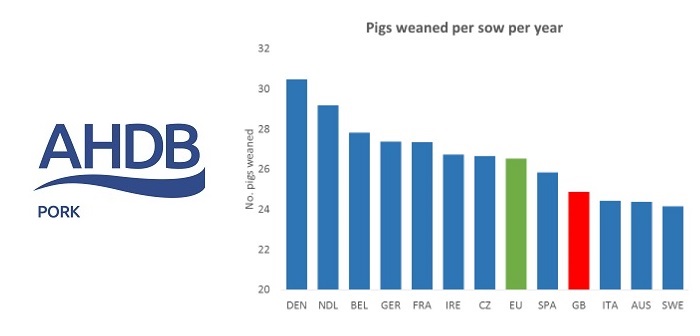The productivity of the GB breeding herd continued to improve throughout the second quarter of 2016, although this progress was partly offset by a slight dip in the performance of the rearing and finishing sectors, according to AHDB Pork.
With the average number of piglets born alive per litter increasing by 0.2, to 12.5, while the number of litters per sow remained constant from the previous quarter, a slight increase in the number of pigs weaned per sow was reported.
“The GB herd still stands behind the EU average in terms of productivity, however, when compared with the most recent InterPIG figures from 2014,” said AHDB Pork. “It is also some way off the pace of the leading producing states, with Denmark posting a figure of 30.46 pigs weaned per sow (2014), versus the GB average for Q2 2016 at 24.86 (pictured above).
It was also reported that the past quarter was better for outdoor herd progress than for indoor systems with the number of pigs weaned per outdoor litter increasing by 0.29 from the previous quarter, to 22.77, while indoor production declined by 0.06 to 26.30 piglets per litter.
“This reverses the trend that has been recorded over recent years, where indoor production improved more than outdoor production,” said AHDB Pork, “although indoor remains the more efficient form of production.”
Looking at feed costs, the second quarter data, as provided to AHDB Pork by Agrosoft, revealed increases in all sectors; sow, weaner and finisher feeds. It was also noted, however, that the rising pig price, of late, which ended the quarter at 124.35 p/kg (EU-spec APP) has helped “soften the blow” of some recent feed price increases.
“There was still a deficit in net margin, however, equating to an average of 12p/kg, or £10 per pig,” said AHDB Pork.
“With pig prices in Q3 comfortably above the Q2 cost of production figure, of 132.3p/kg, it may be hoped that pig producers could start to return to positive margins in Q3, although rising feed costs may dampen this somewhat.
“Continued increases in the physical performance of the breeding and pig herd would help, of course, to capitalise on increasing margins and tighten cost of production levels.”




